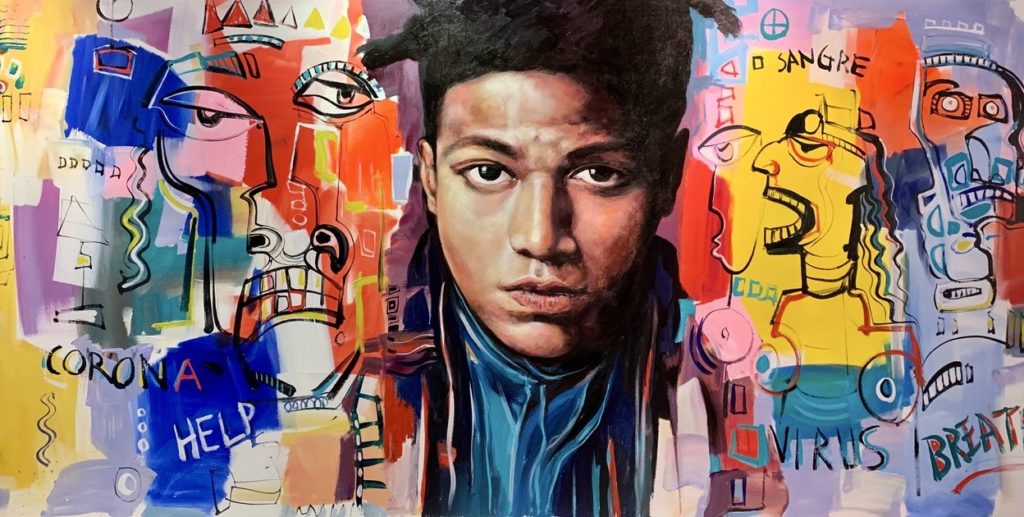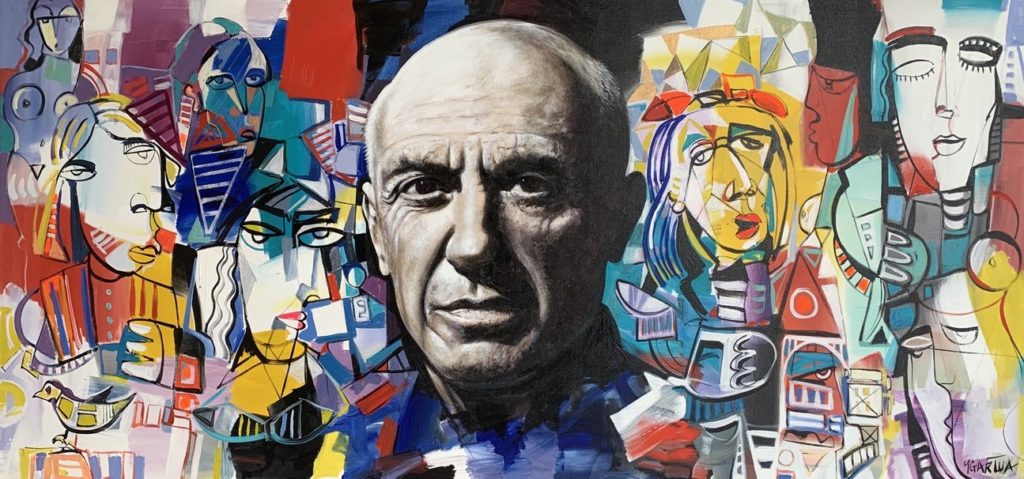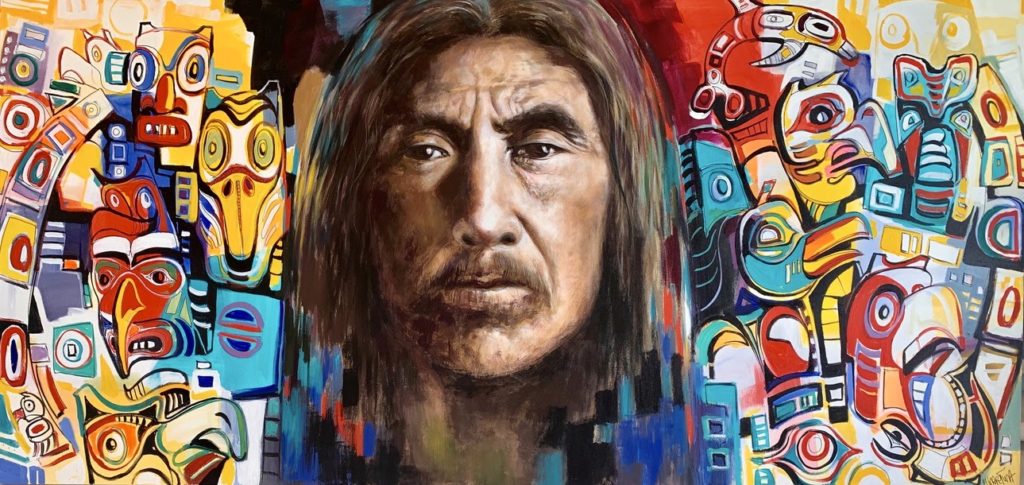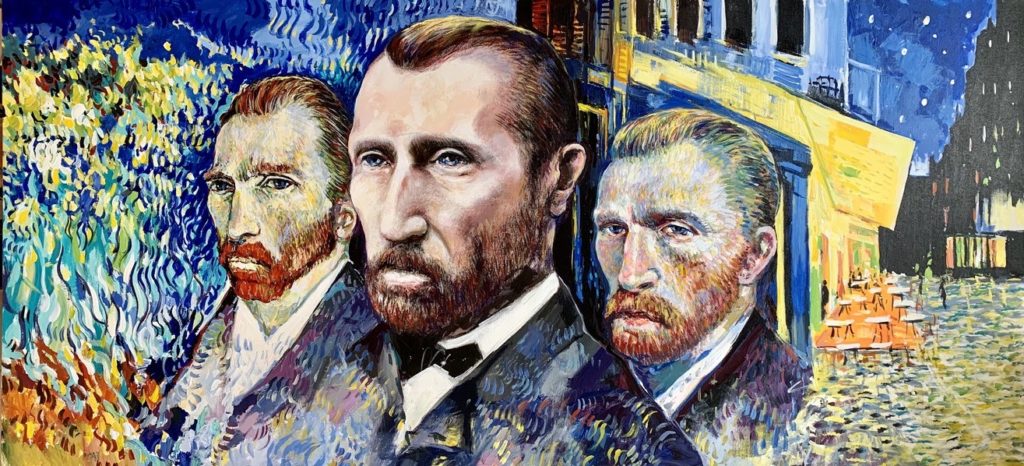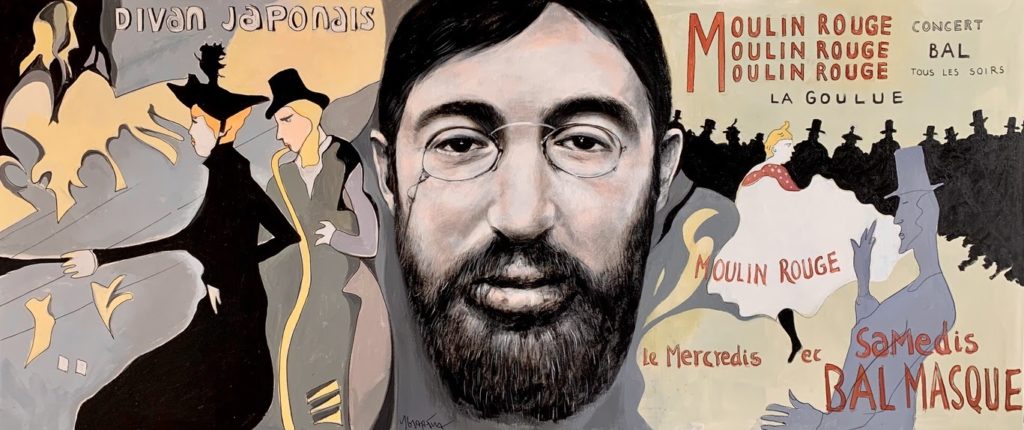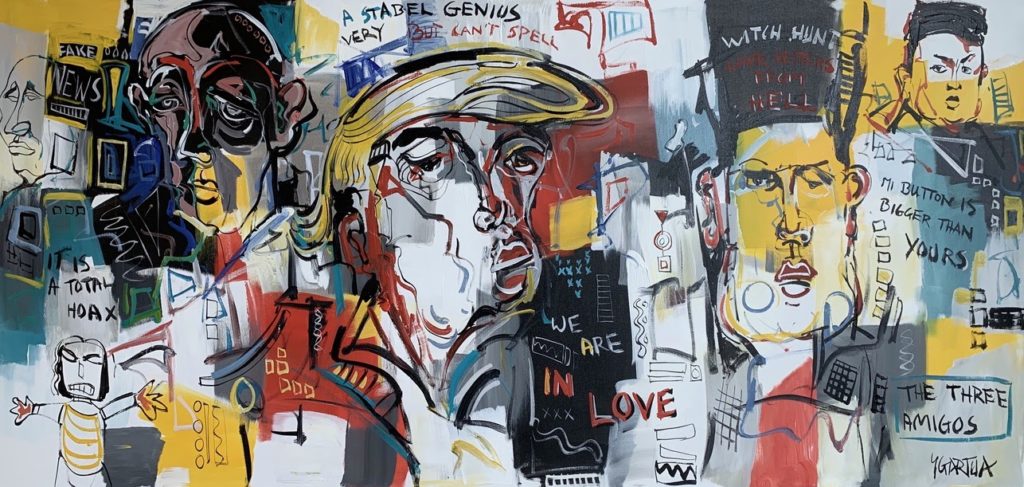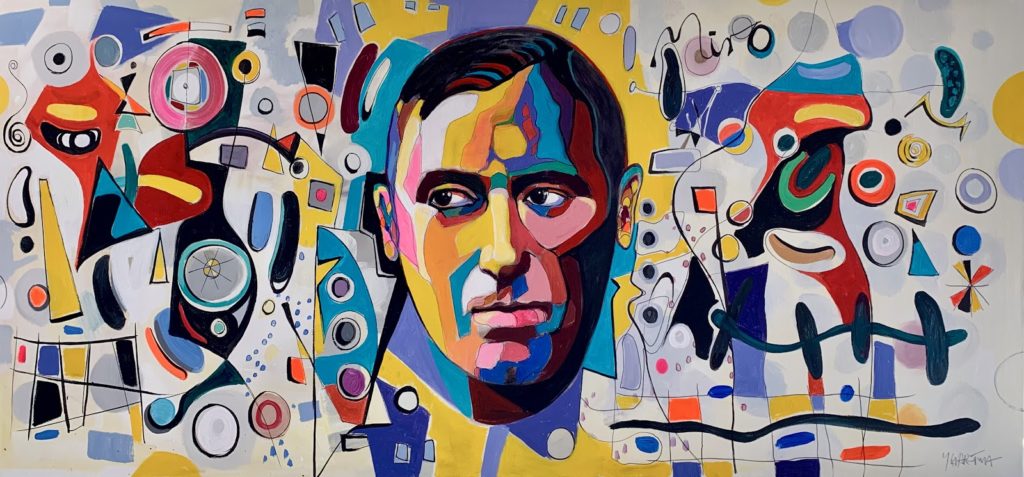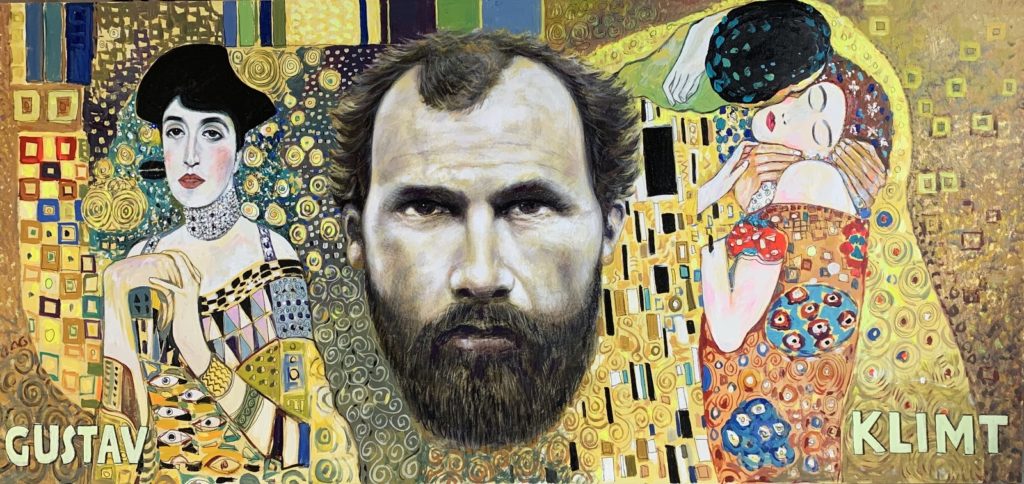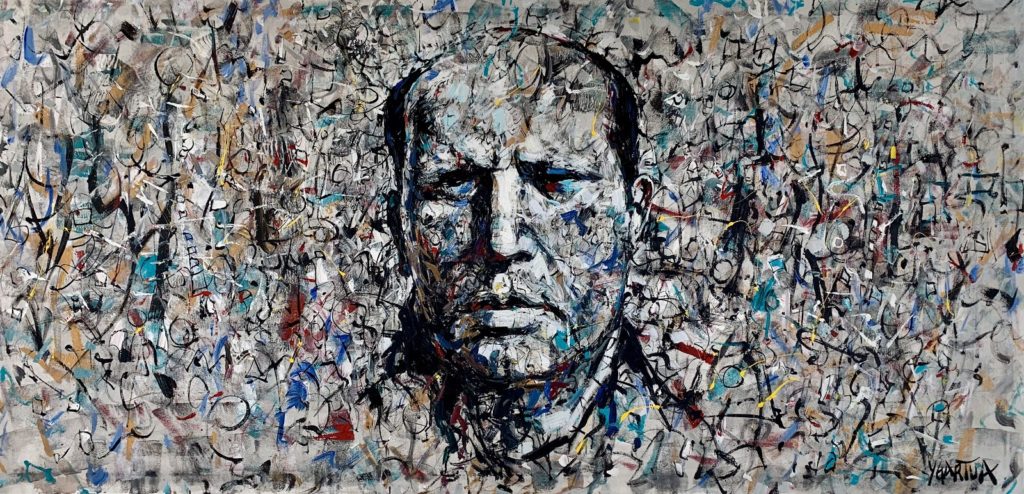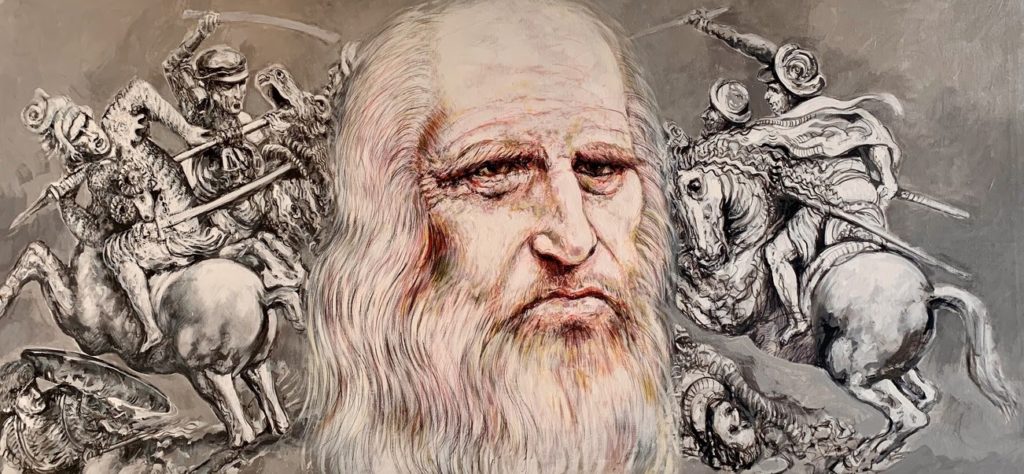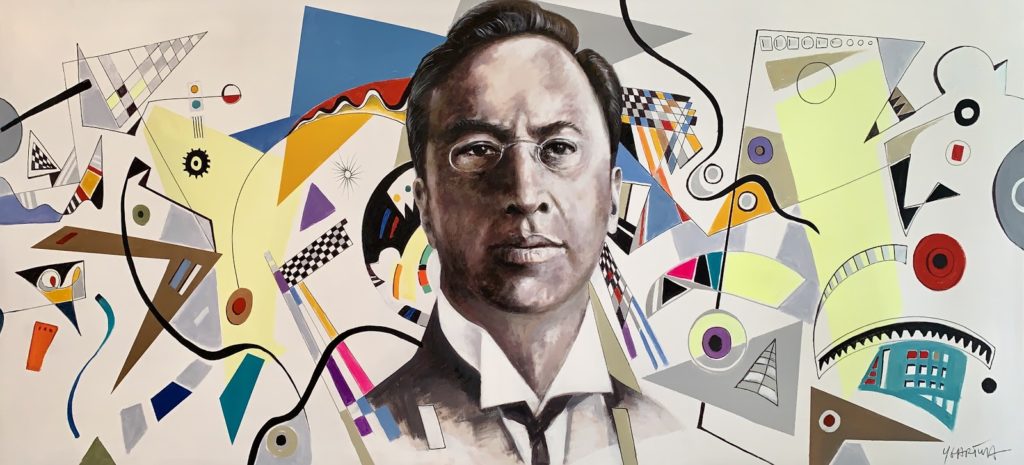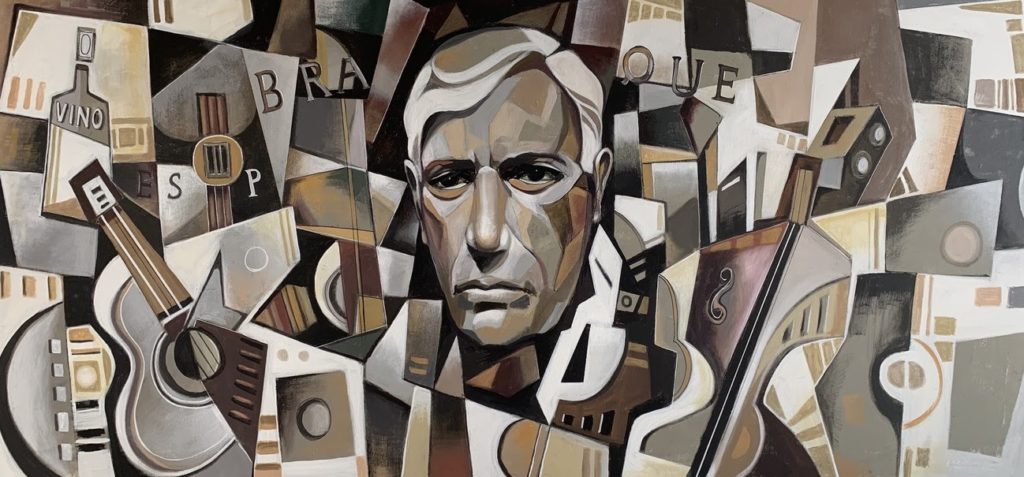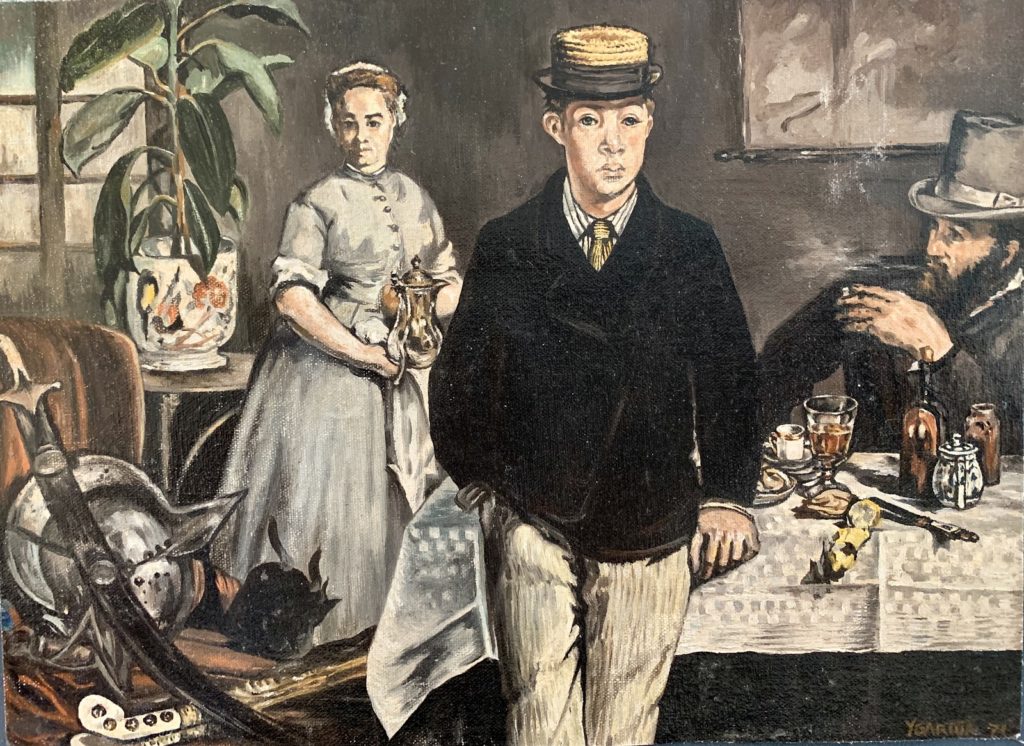TRIBUTES TO THE MASTERS
Our collection of paintings depicting a tribute to the world’s greatest artists is a celebration of the masters who have shaped the art world throughout history. These works of art pay homage to the iconic styles and techniques of some of the most influential artists of all time, from the Renaissance masters to the Impressionists and beyond. Whether you are a fan of the dramatic brushwork of Vincent van Gogh, the sublime beauty of Claude Monet, or the bold abstractions of Pablo Picasso, these paintings are sure to inspire and delight. Each piece in the collection is a testament to the enduring power of art, and a tribute by Paul Ygartua to the artists who continue to inspire and captivate us with their vision and talent.
A TRIBUTE TO JEAN-MICHAEL BASQUIAT
(Dec 22, 1960 – Aug 12, 1988)
Acrylic on Canvas – 90 x 48″
Jean-Michel Basquiat was born on December 22, 1960, in Brooklyn, New York. He first attracted attention for his graffiti under the name “SAMO” in New York City.The neo-expressionist painter, of Haitian and Puerto Rican descent, died in New York on August 12, 1988 of a heroin overdose.In his multicultural home, the artist grew up speaking Spanish, French, English.
It was his graffiti tag “SAMO”(shorthand for the “same old shit”) that first drew public attention. Basquiat created SAMO with his friend Al Diaz while the pair were in high school and the tag which often featured the copyright symbol, cropped up on buildings throughout lower Manhattan and Brooklyn between 1977 and 1980.
Warhol and Basquiat were an unlikely pair; two aesthetic pioneers from different generations, two iconic creative minds of an era, and two good friends. They would forge one of the most important relationships within the history of contemporary art. Warhol, founding Father of Pop Art, and his much younger Neo-Expressionist protege Basquiat emerged from different generations and backgrounds.
But within the span of six years and a deeply intimate albeit turbulent friendship, the mutual respect and admiration that Basquiat and Warhol shared for one another inspired two separately iconic bodies of work, which become eternally emblazoned within the highest echelons of fine art.
“A WORLD IN TURMOIL — It is times like this that you want to make a statement through your art. Reflecting upon the current political and social upheaval and the racial injustice that continues to be the curse on humanity.
Basquiat was the first Graffiti artist that made me appreciate this chosen artistic expression to convey political unrest and disagreement. It was sheer naivety, raw and bold, primal and basic, pertinent to attracting my attention–in such a short life he achieved so much; it was his chosen discipline, his art, to express his criticism of colonialism and racism pertaining to African Americans–he portrayed his sincerity, his personal grievances, with a powerful message that still permeates our society today.”
A TRIBUTE TO PICASSO
(Oct 25, 1881 – April 8, 1973)
Acrylic on Canvas – 40 x 84″
Pablo Ruiz Picasso was a Spanish painter, sculptor, printmaker, ceramicist and theatre designer who spent most of his adult life in France. Pablo Picasso, in full Pablo Diego José Francisco de Paula Juan Nepomuceno Crispín Crispiniano María Remedios de la Santísima Trinidad Ruiz Picasso, also called (before 1901) Pablo Ruiz por Pablo Ruiz Picasso, (born October 25, 1881, Málaga, Spain—died April 8, 1973, Mougins, France), Spanish expatriate painter, sculptor, printmaker, ceramicist, and stage designer, one of the greatest and most-influential artists of the 20th century and the creator (with George Braque) of Cubism.
“My first encounter with meeting an individual who actually had weekly cordial conversations with Picasso at the Cannes market in the South of France, (before he moved on to Antibes –The Musée Picasso, formerly the Château Grimaldi at Antibes, is built upon the foundations of the ancient Greek town of Antipolis. Antibes is a resort town in the Alpes-Maritimes department in southeastern France, on the Mediterranean Sea–just 20 minutes from Cannes)was one of the owners of one of our apartments in Cannes. Our daughter Tala Nicole was born there in 1979 and our children did attend school there over a six year period. I had many studios in Cannes – inspiration is in the air, it is the allure of another era, the Cote D’Azur is a magical part of the world for artists and visitors alike. We also spent summers in Sitges, Cataluna, a seaside resort 20 minutes from Barcelona — Paloma, Picasso’s daughter, owned a bar there–and she often reminisced about her Father, Picasso. El 4 Gats, the famous restaurant where Dali, Picasso and many other artists frequented throughout the modernist period was also one of our stomping grounds during the summer months when we were there. When living in France and Spain, you are surrounded by the history and the culture of the country and it is important to them to preserve their history, the artists that have influenced the people and the historical happenings going on since the beginning of time. PICASSO is there, and we are all influenced by his work and just being there where he worked, where he found inspiration, where he created some of his masterpieces is and has always been an incentive and motivation to my creativity and inventiveness.We have crossed paths many times where Picasso lived and exhibited and in the early 70’s I painted many works for one of Dali’s agents while living in Sitges, (Barcelona)Spain.”
“ Our goals can only be reached through a vehicle of a plan, in which we must vigorously act. There is no other route to success”.
A TRIBUTE TO EDWARD S. CURTIS
(Feb 19, 1868 – Oct 19, 1952)
Acrylic on Canvas – 90 x 44″
Edward S. Curtis, American Photographer and Ethnologist whose work focused on the American West and on Native American people. The Vanishing Race by Edward S. Curtis (1904). He sought to document the assorted tribes fearing the imminent disappearance of America’s first inhabitants.
“Edward S. Curits’s photography of our North American natives was brought to my attention by my wife Joanne, in 1974. It was not my first introduction to our native people of North America, but it was the first time I contemplated them as a subject matter. I never considered myself as a portrait artist, but I have always been drawn to the story behind the face, the history, the emphasis on capturing the power of their presence. I was intrigued with Curtis’s lifestyle, crossing America, camping outside the native reservations, awaiting for them to come, anticipating their curiosity and interest to trust him enough and permit him to photograph an historical record of our First People of North America.
With reference to my own Basque Heritage, I have always had an empathy and compassion for one’s sacred right to preserve and cherish their heritage. It is like an endless passion and dedication to present our natives with dignity and to stand up for the rights of our First People.
I have painted nearly all of Curtis’s studies, the most eloquent record on our native people(from 1974 until present day 2020). When painting the natives, our First People of the World it is often in a form of a visual statement, it is motivational, it is important. Over the years it really seems that a guiding hand is directing me to create a tableau, a record of character portraying the Nomadic People of the World. It seemed that some instinctive and natural inquisitiveness drawn from my Basque Heritage – which is one of the oldest known ethnic groups in the world – was acting as a force which impelled me to seek out those fundamental values which are the root foundations of all civilizations.
This painting is a Tribute to Edward S. Curtis, through his important work, recording the history of the North American Natives it furthered my understanding and fascination of our world–it took me on my own journey, seizing the opportunity to record our natives across North America. In Arizona I painted the Navajos and Hopis where I was a resident artist; we lived and worked with the De La Mano Gallery in Scottsdale. I painted the Incas and the Aztecs (Teotihuacan,Mexico) for the Golden Cactus Gallery in Cabo San Lucas and San Jose, Mexico and I painted the natives from the Amazon during our 6 month sojourn in Rio de Janeiro. My introduction locally to the Burrard Band and was honoured by the friendship with Chief Leonard Geroge, son of Chief Dan George, the Musqueams, the Haidas — to my native mural in Chemainus and to my mural in Denny Island, portraying the Heiltsuk natives from Bella Bella. The journey continues, but looking back, I am beholden to those who inspire me and to the opportunities given to me–remembering that one memorable event in February,1978– a delightful afternoon in Scottsdale, Arizona, when we were visited by Edward S. Curtis’s daughter, to thank me for portraying her Father’s work in my paintings and the opportunity, first hand, to hear about her Father’s travels and Rooselvelt’s golden edged copy of Edward S. Curtis’s book. These are the things that I remember and are forever grateful.”
A TRIBUTE TO VAN GOGH
(Mar 1853 – Jul 29, 1890)
Acrylic on Canvas – 84 x 40″
VINCENT WILLEM VAN GOGH (March 1853, Zundert, Netherlands – 29 July 1890 Auvers-sur-Oise, France)
HIS EMOTIONS DICTATED HIS PALETTE AS HE PAINTED ACCORDING TO HIS FEELINGS Vincent van Gogh was one of the world’s greatest artists, with paintings such as ‘Starry Night’ and ‘Sunflowers,’ though he was unknown until after his death. He was a Dutch post-impressionists painter who is among the most famous and influential figures in the history of Western art. In just over a decade, he created about 2,100 artworks, including around 860 oil paintings, most of which date from the last two years of his life. They include landscapes, still lifes, portraits and self-portraits (which he did to practise painting people and majority done in Paris -1886-88.) Born into an upper-middle-class family, Van Gogh drew as a child and was serious, quiet and thoughtful. As a young man he worked as an art dealer, often travelling. He turned to religion and spent time as a Protestant missionary in southern Belgium. He moved back home with his parents and did not start painting until his late twenties when he moved to Paris for a two year period where he met members of the avant-garde including emile Bernard and Paul Gaugin. While in Paris he was greatly influenced by Impressionism and Post Impressionism and gained exposure to artists such as Gaugin, Pissarro, Monet and Bernard. As a result, he adopted brighter, more vibrant colors in his art. The appearance of Vincent Van Gogh’s art was transformed by his experience of French Impressionist painting… For him, the quintessential Impressionist painter was always MONET.
A HOMAGE TO VINCENT WILLEM VAN GOGH
This painting portrays two of his self portraits, the right hand-side, the self-portrait of 1887, now at the Art Institute of Chicago and on the left hand-side, self-portrait of 1889 at the Musee d’Orsay and the center portrait I did from one of his early photographs (1870).The earlier portrait on the right hand side shows a more traditional style, even though there were interesting colours and dubbing– but the painting on the left, has much more drama, originality and far more powerful — you can see at that point where his direction was going.
It is interesting how his work developed in that two year period during his sojourn in Paris, possibly influenced by Monet and the Post-Impressionist artists –introducing more colour and the technique of dubbing.. I introduced The Cafe Terrace on the Place du Forum Arles as a backdrop –Vincent moved to Arles in 1888, propelled by a number of reasons. Weary of the frenetic energy of Paris and the long months of winter, Van Gogh sought the warm sun of Provence. During his stay in Arles between February 1888 and May 1889, he executed about 300 paintings and drawings.
Van Gogh was an artist that stood out to me, right from the beginning, one of my favourite artists. It was the earthiness, the impulsive and expressive brushwork that aroused my interest–he was there at the beginning –he contributed to the foundations of modern art. Contrary to what many people think, he was born into an upper-middle class family. He came from an educated and very influential family, his Father being a minister and his close relationship with his brother Theo van Gogh, who was an art dealer and provided his brother with financial and emotional support, and access to influential people on the contemporary art scene. Afflicted by many years of illness he unfortunately left our world at only 37 years of age.
The main reason I fell in love with Van Gogh and his work was because as an artist who was either bio-polar or an epilectic and to be able to paint through the mental anguish he was suffering must have been practically impossible. Although, he himself said in his writings, that more than doctors, painting helped to relieve the pressure which I believe to be true. I myself have painted when I had an accident on the Chemainus mural when the ladder broke and I had a 20 ft. drop and completely fractured my heel, but while painting, the pain does seem to be alleviated. In his work you can see and feel his anguish, especially the last painting he did of the crows in the corn field, he felt that they were coming out of his head and invading his body.”
The fervor and fragility of Van Gogh’s life are told on his canvases (of many of his self-portraits) by stark contrasts of color and restless brushstrokes. Heavy lines of paint seem to emanate from his head like a wavering force field, energized by his own intensity. This background sets off the complementary colors of his green-tinged face and orange hair, keying his image to a higher pitch. “I was thin and pale as a ghost,” Van Gogh wrote as he described this portrait to Théo. “It is dark violet blue and the head whitish with yellow hair, so it has a color effect.
A TRIBUTE TO TOULOUSE-LAUTREC
(Nov 24 1864 – Sep 9, 1901)
Acrylic on Canvas – 84 x 36″
Henri de Toulouse-Lautrec (November 24, 1864 Albi, France — September 9, 1901, Saint-Andre-du-Bois, France)
THE ARTIST WHO CAPTURED PARIS’ Cabarets and Dance Halls Henri de Toulouse-Lautrec was a French painter, printmaker, draughtsman, caricaturist, and illustrator whose immersion in the colourful and theatrical life of Paris in the late 19th century allowed him to produce a collection of enticing, elegant, and provocative images of the modern, sometimes decadent affairs of those times. Toulouse-Lautrec is among the best-known painters of the Post-Impressionist period, with Paul Cezanne, Vincent van Gogh and Paul Gauguin. The scene Lautrec stepped into was in the working-class district known as Montmartre, notorious for its thieves and brothels as well as its hangouts for avant-garde artists and literary anarchists. Within a decade he would be famous for his spectacular posters of the Moulin Rouge and other Parisian dance halls. More than a century later, his black-stockinged, high-kicking dancers with their layered petticoats and plumed hats remain among the most popular and striking images of modern art. (The Musee d’Orsay-the largest impressionist art collection in the world, located on the left bank of the river Seine, 7th arrondissement of Paris.
“Enthralled by the history of the City of Lights and surrounded by all that could enchant the eye and enrapture the imagination, it is no wonder that artists from around the world want to experience painting and being there.
“Throughout the years, the life story and the wonderful figurative work of Toulouse-Lautrec made a life-long impression upon me–his work captivated you, taking one to another epoch. I just imagined that I was in Paris back in the late 1800’s.– a transcending experience, especially when you are living in Paris. It is in the air, it is everywhere, from the museums, to the posters in the streets, everybody in Paris is influenced a great deal from the era of the impressionists. It is the reason that Paris can claim that they are the center of the art world and it is one of the reasons that artists from all over the world want to experience painting and being there–the left bank of the Seine, Montmartre, it is all there. Lautrec was painting by day and carousing by night, sketch pad in hand –he had a short, wild life and fortunately he had the money to support his vices. He had many subjects, the dancers, the ladies of the night, very colourful, very adventurous, exciting and most important he was a VIP at the Moulin Rouge.–a nightlife-loving aristocrat, absinthe-soaked, bohemian 19th century Paris. It is the City of Art, home to some of the world’s most famous museums and galleries including the Louvre and the Musee d”Orsay, the city today remains home to a thriving community of artists.’
A TRIBUTE TO GRAFFITI ART
Los Tres Amigos
Acrylic on Canvas – 84 x 40″
“I was inspired at this time 2020, with the Pandemic, the Political Turmoil– to express my dismay in our world leaders who continue to disrupt and interrupt political accord. I like the graffiti style as it takes you back to the basics, it is a statement straight from the gut, no frills, right to the point – primitive, gutsy, impulsive and true freedom of expression.
Artists such as Basquiat, and today Banksy–bring political messages to the attention of the public– taking art to the ghetto, to the streets, to normal people, to everyday life. A form of activism, artistic protest, graffiti may be one of the most long-lasting artistic and political protests. Taking over public space, claiming the power of the individual and independent expression. Politics are important, speaking to what is happening in society.”
A TRIBUTE TO JOAN MIRO FERRA
(Born: April 20, 1893, Barcelona, Spain Died: December 25, 1983)
Acrylic on Canvas – 84 x 40″ (213 x 102cm)
Joan Miró i Ferrà was a Spanish painter, sculptor, and ceramicist born in Barcelona. Joan Miró was a Catalan painter who combined abstract art with Surrealist fantasy. His mature style evolved from the tension between his fanciful poetic impulse and his vision of the harshness of modern life. He worked extensively in lithography and produced numerous murals, tapestries, and sculptures for public spaces. A museum dedicated to his work, the Fundació Joan Miró, was established in his native city of Barcelona in 1975, and another, the Fundació Pilar i Joan Miró, was established in his adoptive city of Palma de Mallorca in 1981. Wikipedia The Museum of Modern Art, The Art Institute of Chicago Periods: Surrealism, Fauvism, Cubism, Abstract expressionism
“I found Miro’s work different from the other painters at the time, where some of his works took on a more child-like surrealistic fantasy –original, very modern and colourful–extraordinary.”
“Since 1972 (yearly) I have been living and painting in Sitges (20 minutes from Barcelona). Miro, Dali, Picasso are the three artists that predominate the museums in Barcelona — each with their own individual museums. Miro–The Fundació Joan Miró is a museum of modern art honoring Joan Miró located on the hill called Montjuïc in Barcelona, Catalonia. Picasso–The Museu Picasso, located in Barcelona, Catalonia, Spain, houses one of the most extensive collections of artworks by the 20th-century Spanish artist Pablo Picasso. The Dalí Theater Museum is the most important museum dedicated to the Catalan surrealist artist Salvador Dalí. Located in his hometown of Figueres,(a couple of hours from Barcelona and 25 minutes from Cadaques, my other favourite studio in Cataluna).
When living in Cataluna you are emerged into the culture, the language and the arts– the topic of conversation is often about these three artists as they lived there, went to school there, and painted there. Barcelona has always attracted art historians, art enthusiasts, tourists, from all over the world to learn and view some of the world’s most famous artists and the famous architect Gaudi — La Sagrada Familia — miraculous. We passed this cathedral throughout the years as we have life-long friends that live just down the street from this cathedral. It is awe-inspiring.
A TRIBUTE TO GUSTAV KLIMT
(July 14, 1862 – February 6, 1918)
Acrylic on Canvas – 84 x 40″ (213 x 102 cm)
Gustav Klimt was an Austrian symbolist painter and one of the most prominent members of the Vienna Secession movement.
Austrian artist Gustav Klimt is one of the most celebrated Symbolist artists. During his successful career, he cultivated a portfolio comprising academic paintings, life drawings, and even decorative art objects. Still, he is most well-known for the collection of glistening, gilded works he produced during his Golden Phase. Klimt co-founded the Secessionist Movement in 1897. Rejecting Vienna’s traditionally conservative art scene, Klimt and other Secessionists gave Vienna’s contemporary artists a platform to share their work. This liberating movement inspired and allowed Klimt to experiment with his art and develop a Symbolist style inspired by the Art Nouveau and Arts and crafts movements. .
Gustav Klimt is best known for his opulently gilded art nouveau portraits of women that epitomize fin-de-siècle Vienna. His Symbolist pastiches of pale nudes, allegorical gardens and erotic content served as the basis for many American psychedelic poster designs in the 1960s. Early in his career, Klimt was supported generously by the Viennese community, and received several commissions for murals in theaters and the Museum Kunsthistorisches. Early narrative paintings depicted heavy subjects such as anxiety, doubt, sexuality, and death, but in later years, he turned toward landscape painting, exploring light and abstract patterns of nature. His most famous paintings are The Kiss (1907) and Portrait of Adele Bloch-Bauer (1907), which sold for a record auction price of more than 100 million dollars in 2006.
“The Kiss” is the final painting of Klimt’s Gold Period, during which he incorporated gold leaf into his works. This practice reflects the strong influence of the gold-detailed religious art of the Middle Ages as well as the sacred works created by artists of the Byzantine Empire.This luminous period lasted about a decade, yet it has come to characterize Klimt’s style and has resulted in some of modern arts most well-known and valuable paintings.
“The central focus is on Klimt, I chose a black and white photograph of him from the archives, dated 1902. I decided on this study as he has the allure of an artist, with a profound expression and a touch of craziness which depicts the inner passion which artists draw on to paint wonderful artwork. It also shows a very sensitive side, as I noted with his black and white cat, he seems to adore this big black and white cat which shows up in many of his personal photos. In 2016 I was exhibiting at an international exhibition in Vienna at the MOYA, Museum of Young Art, the Palais Schonborn, in the heart of Vienna and of course if you are in Vienna you must go to Klimt’s museum.
I was fortunate to see many of Klimt’s works at the Osterreichische Galerie Belvedere Museum. Klimt’s glistening “Golden Phase” was impressive and the gold leaf which he used during this period created a third dimension in the texture and the depth of the design—quite spell-binding, the intensity, the allure of gold is often a feature that I like to present in my paintings. The depth in his works was due to the intricate design which left one following the brush work into the grooves and the gold highlights and texture.
It was important for me to view Klimt’s last and most famous painting of this period THE KISS (Der Kuss) is considered a masterpiece of Vienna Secession (local variation of Art Nouveau) and Klimt’s most popular work. It was 72 x 72 inches — it reached out to you, it was impressive and beautifully executed”.
A TRIBUTE TO JACKSON POLLOCK
(January 28, 1912 – August 11, 1956)
Acrylic on Canvas – 84 x 40″ (213 x 102 cm)
“The painting has a life of its own. I try to let it come through” – Jackson Pollock
He was an influential American painter, and the leading force behind the abstract expressionist movement in the art world. During his lifetime, Pollock enjoyed considerable fame and notoriety. Jackson Pollock’s greatness lies in developing one of the most radical abstract styles in the history of modern art, detaching line from color, redefining the categories of drawing and painting, and finding new means to describe pictorial space.
Jackson Pollock was born in Cody, Wyoming in 1912. His father, LeRoy Pollock was a farmer and later a land surveyor for the government. Jackson Pollock grew up in Arizona and Chico, California.
To this day Jackson Pollock is known as a leader in the most important 20th century American art movements. The risks and the creative approaches he took, led future artists to create with passion, as opposed to trying to follow set boundaries or guidelines.
“All artists have been influenced by Pollock. It was his spontaneity action art with no particular subject that I found compelling. A dynamic combination of line and colour and paint dripped and spread over a large canvas — spontaneous and fast gives you a feeling that the artist was in a passionate rage to complete the painting. His work was an important contribution in the 20th century, of styles, representing full contact painting. I put his work in the top ten of my favourite artists, because of his originality and the freedom of his expression.”
A TRIBUTE TO LEONARDO DA VINCI
(April 15, 1452 Italy – May 2, 1519, France)
The Battle of Anghiari, Acrylic on Canvas – 84 x 40″ (213 x 102 cm)
Leonardo da Vinci was a Renaissance artist and engineer, known for paintings like “The Last Supper” and “Mona Lisa,” and for inventions like a flying machine. He was a Renaissance painter, sculptor, architect, inventor, military engineer and draftsman — the epitome of a true Renaissance man. Gifted with a curious mind and a brilliant intellect, da Vinci studied the laws of science and nature, which greatly informed his work. His drawings, paintings and other works have influenced countless artists and engineers over the centuries.
The Battle of Anghiari is a lost painting by Leonardo da Vinci at times referred to as, “The Lost Leonardo”, which some commentators believe to be still hidden beneath later frescoes in the Hall of Five Hundred (Salone dei Cinquecento) in the Palazzo Vecchio, Florence. Its central scene depicted three men riding raging war-horses engaged in a battle for possession of a standard. Sometime around October 1503, Leonardo was commissioned to paint the mural of The Battle of Anghiari, for the Sala del Gran Consiglio, the recently rebuilt Great Council Hall of the Palazzo Vecchio in Florence, during the first years of the city’s republican government.
“The first time I saw an original work of art by Leonardo da Vinci was a field trip to London with my first Art School from Liverpool–Laird School of Art–1960 (just before I went onto Liverpool College of Art).
It was called the Leonardo Cartoon and it was only just acquired at the National Gallery in London in 1960–The Virgin and Child with Saint Anne and Saint John the Baptist, sometimes called The Burlington House Cartoon, is a drawing by Leonardo da Vinci. The drawing is in charcoal and black and white chalk, on eight sheets of paper glued together. It is now back in Italy.
As it was just acquired in London it was important for our Art School to take this special field trip to view the original–The Leonardo Cartoon. We studied Leonardo in my life study, for life drawings– we had to study the limbs of the body to learn how to do three dimensional drawing. Obviously, he was the master of drawing detail and the human body. I particularly liked his drawings in the red pencil. As there is such an enigma behind The Lost Painting, The Battle of Anghiari it was more intriguing to paint it–it arouses one’s curiosity, as in the Mona Lisa, always captivating, with an air of mystery.”
A TRIBUTE TO KANDINSKY
(May 13, 1882 – August 31, 1963, Paris, France)
Acrylic on Canvas – 84 x 40″ (213 x 102 cm)
“I liked Kandinsky’s clean dimensional drawings, very geometrical, architectural, with precise detail, and the balance of the composition and the line work is very important–he comes across as a perfectionist, not only in his work, but in his appearance and his success in everything he attempted. It was apparent that he enjoyed the challenges of discovery, invention and innovation”.
One of the first creators of pure abstraction in modern painting. After successful avant-garde exhibitions, he founded the influential Munich group Der Blaue Reiter (the Blue Rider) and began completely abstract painting. His form evolved from fluid and organic to geometric and finally to pictographic.
Wassily Wassilyevich Kandinsky was a Russian painter and art theorist. Kandinsky is generally credited as the pioneer of abstract art. Born in Moscow, Kandinsky spent his childhood in Odessa, where he graduated at Grekov Odessa Art school. He enrolled at the University of Moscow, studying law and economics. Wikipedia
Kandinsky achieved many things in his lifetime — including degrees in law and economics. He came from a very influential family … one of his great grandmothers was a Princess Gantimurova, probably explaining the “slight Mongolian trait in his features”. During the Russian Revolution (1917), which overthrew the Czar, the ruler of Russia, the artist held an important post at the Commissariat (government bureau) of Popular Culture and at the Academy in Moscow. He organized twenty-two museums and became the director of the Museum of Pictorial Culture. In 1920 he was appointed professor at the University of Moscow. The following year he founded the Academy of Arts and Sciences and became its vice president. At the end of that year, the Soviet attitude toward art changed, and Kandinsky left Russia.
A TRIBUTE TO GEORGE BRAQUE
(January 23, 1832 France – April 30, 1883 Paris, France)
Acrylic on Canvas – 84 x 40″ (213 x 102 cm)
“I have introduced Braque’s image in a stylized cubistic style, similar to his style of cubism. The backdrop continues as an example of his usage of vertical and horizontal structure and sharp angles. During the wartime period, the work he put together would change in order to represent the somber, dark period the world was going through and these are the colours I have used here. After reading about Picasso and hearing about the other artists that would not let him in their studios, knowing he would steal their ideas, I imagine Braque as being the inventor of Cubism as I can’t imagine Braque copying Picasso.”
A TRIBUTE TO EDOUARD MANET
(January 23, 1832 – April 30, 1883 Paris, France)
Acrylic on Canvas
Édouard Manet was a French modernist painter. He was one of the first 19th-century artists to paint modern life, and a pivotal figure in the transition from Realism to Impressionism. Wikipedia The Luncheon in the Studio 1868 Edouard Manet, oil on canvas, depicted people, Leon Leenhoff Suzanne Manet, Edouard Manet, Jose-Auguste Rousselin (118 cm–46.4in) Width (l53.9cm–60.5in) The Metropolitan Museum of Art, National Gallery of Art, Periods: Impressionism, Realism, Modern Art, Modernism
“In 1970 we decided to go to Acapulco for six months, we had an old Zephyr, one mechanic said it would never make it past Seattle, and another friend, Tom, who owned a garage said the old Zephyr always gets you there. Well, there were some problems on the way, fan belt went, a few little things, but after a long arduous trip we arrived in the heat of the day, hot and humid, like a tropical jungle, to one of Mexico’s oldest beach resorts and a port since the early colonial period of Mexico’s history. We rented a great bungalow by the beach and there I painted for six months. I wanted to challenge myself by doing a miniature painting of Manet’s Luncheon in the Studio 1868, one of my favourite realist painters. This painting is now in the Ygartua Family Collection.”

